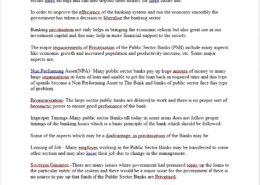Draw attention to the key components of the Goods and Services Tax. Give a summary of its successes since implementation as well as the difficulties it continues to confront. (Answer in 200 words)
Flexible exchange rate is also called as floating exchange rate which is a monetary policy. In this value of currency is determined by the foreign exchange market, this policy is in contrast with the fixed exchange rate in which value of currency is fixed by the government or the central bank of theRead more
Flexible exchange rate is also called as floating exchange rate which is a monetary policy. In this value of currency is determined by the foreign exchange market, this policy is in contrast with the fixed exchange rate in which value of currency is fixed by the government or the central bank of the country.
The value of currency can fluctuate because of the market forces such as supply and demand forces in the market.
Appreciation of the Indian rupee in relation to the US Dollar means the rupee has become stronger against the dollar. We can buy more dollars with rupees than before.
Factors leading to appreciation are as follows:-
1. Increase in the value of Indian Rupee related to the US dollar.
2. Rupee becomes stronger against the dollar.
3. Eg.The value of 1 US Dollar decreased from ₹75 to ₹70.It means now we can buy $1 with ₹70 for which we used to pay ₹75 before.
Depreciation of the Indian rupee is the opposite of appreciation of rupee.In this the Rupee becomes weaker in relation to the US Dollar, we will get less dollars with rupees now.
Factors leading to depreciation of the Indian rupee are as follows:-
1. Decrease in the value of Indian Rupee related to the US Dollar.
2. Rupee has become weaker against the dollar.
3. Eg. The value of Doller has increased from ₹70 to ₹75. It means earlier we used to pay ₹70 to buy $1 but now we have to pay ₹75 for the same.
The appreciation and depreciation can be caused by many different factors such as Trade balances, inflation rate, political instability, export-import, interest rates, foreign investment etc.
Appreciation of rupees leads to increase in purchasing power of Indian consumers but negatively impacts export and import of the country whereas depreciation benefits the export-import.


Goods and Services Tax (GST) is an indirect tax that came into effect on 1st July 2017 by replacing many indirect taxes in India such as the excise duty, VAT, services tax, etc. Goods and Service Tax (GST) is levied on the supply of goods and services and is a destination-based tax that is levied onRead more
Goods and Services Tax (GST) is an indirect tax that came into effect on 1st July 2017 by replacing many indirect taxes in India such as the excise duty, VAT, services tax, etc. Goods and Service Tax (GST) is levied on the supply of goods and services and is a destination-based tax that is levied on every value addition.
Salient features of the Goods and Services Tax:
Since its implementation in 2017, the GST has achieved the following milestones:
However, several challenges still need to be addressed, such as:
While the government has worked to solve many issues, considerable intervention is still required to bring GST to its full efficiency. The proposal to have a single return will simplify compliance and do away with matching requirements. Such a step will bring out the true sense of ‘One Nation, One Tax’.
See less